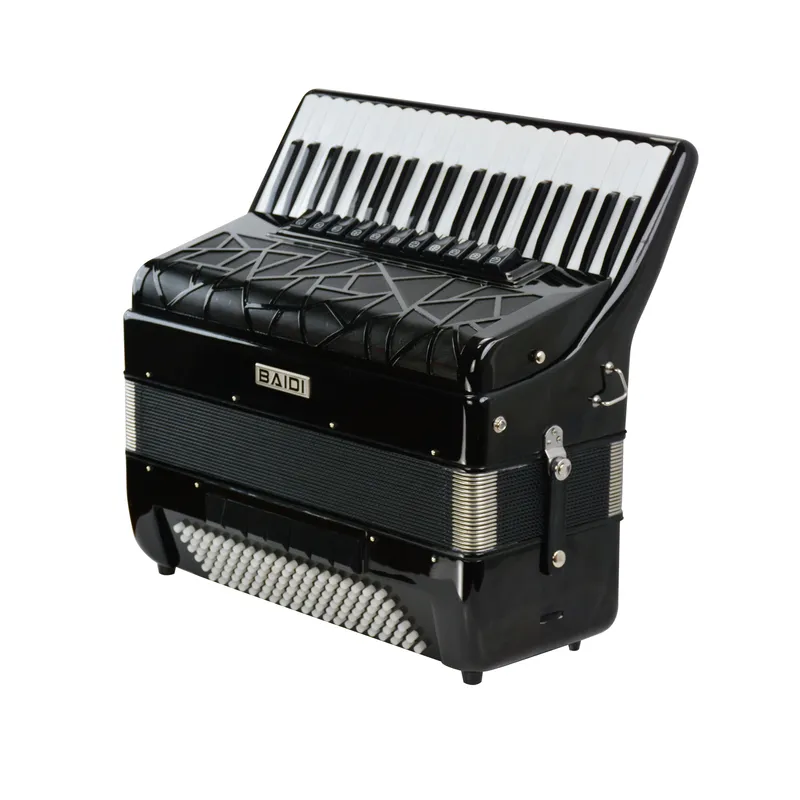If you’re exploring accordion options, you’ve probably encountered the common question: button accordion vs piano accordion. Both types offer unique advantages for performers, educators, and distributors alike. Understanding their differences can help you choose the right accordion for your needs or your clients’ preferences.
This article breaks down the main features of button accordions and piano accordions, covering key layout, learning curve, range, portability, tone, and cost. As experienced accordion manufacturers and suppliers, we aim to guide you toward an informed decision.

Structural Differences Between Button Accordion and Piano Accordion
Piano Accordion: Familiar Keyboard Layout
The piano accordion features a keyboard similar to that of a piano. Its clear arrangement of black and white keys offers intuitive fingering, making it an excellent choice for beginners or those with piano experience. This layout facilitates visual positioning and helps muscle memory development.
Button Accordion: Compact and Versatile Buttons
In contrast, the button accordion has round buttons arranged compactly. It comes in two main systems: bisonoric (different notes when pushing or pulling the bellows) and chromatic (same note on push and pull). The chromatic button accordion offers a denser range, favored by advanced players for fast fingering and complex music.
Summary: Piano accordions suit players seeking an easier start, while button accordions appeal to those wanting more flexibility and range for advanced performance.
Learning Curve and Playing Styles for Button Accordion vs Piano Accordion
Piano Accordion: Easier for Beginners
Due to its keyboard familiarity, the piano accordion generally has a gentler learning curve. Many music schools prioritize it for beginners and group lessons, making it ideal for teaching environments.
Button Accordions: Technical and Expressive
The button accordion, especially chromatic types, excels in technique and modulation. Its symmetrical design allows quick adaptation to different keys, fitting for classical, jazz, and modern repertoire, requiring high skill. Folk styles like polka often use two-note gong button accordions, whose unique push-pull tones add rhythmic interest.
Range and Expressiveness Differences
Button accordions provide more scales and chord options in a compact size, offering extensive expressive possibilities. However, mastering them requires a higher skill level.
Piano accordions come in varied sizes—from lightweight 34-key models to professional 41-key versions with up to 120 bass buttons, catering to beginners, educators, and professional performers alike. This variety supports diverse performance needs and teaching scenarios.
Weight and Portability Considerations
For traveling musicians or teachers, size and weight matter. Button accordions, especially smaller folk styles, tend to be lighter and more compact, perfect for frequent transport.
Piano accordions usually have a larger body due to the keyboard, but many modern designs keep weight manageable. For example, 34-key models weigh around 7-8 kg, suitable for students and casual players.
Tone Quality, Durability, and Cost-effectiveness
Tone largely depends on reed quality and bellows airtightness, regardless of accordion type. Our accordions undergo rigorous testing to ensure clear, full sound output.
We emphasize comfortable button/key feedback for smooth playability.
As a leading accordion manufacturer and supplier, BeatBulk offers factory-direct pricing, low minimum orders, customizable options, and reliable delivery, trusted by global distributors and music schools.
Recommended Button Accordions and Piano Accordions from BeatBulk
We provide a wide range of accordions suitable for various users:
- J60-K (34-key/60-bass piano accordion): Ideal for beginners. Clear sound, light (7.2 kg), and portable.
- 37-key/96-bass button accordion: Colored buttons, designed for advanced players, support quick tonal changes.
- 41-key/120-bass professional piano accordion: Features a Cassotto sound chamber for rich tones, perfect for stage performances.
All products support wholesale and customization for different markets and teaching needs.
Conclusion: Choosing Between Button Accordion vs Piano Accordion
There is no absolute better choice. Your decision should consider:
- Do you want a quicker start with familiar keys?
- Do you need versatility to play in multiple keys and styles?
- Will the accordion be used mainly for teaching, practice, or professional performances?
- Is portability a major concern?
- Are you looking for specific tonal qualities?
BeatBulk is committed to providing professional, customizable, and high-quality accordions to meet your needs.
Ready to find the perfect accordion for your business or school?
Contact us today to explore our product range, request a quote, or discuss custom solutions. Let’s make music together!







